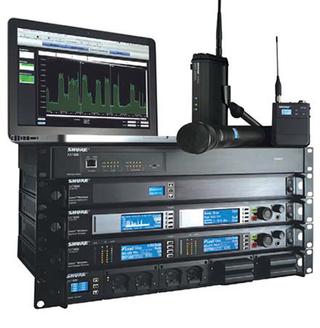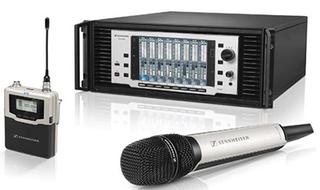Wireless Mic Vendors Aim at Moving Target

David Marsh
LOS ANGELES—Despite the FCC’s recent announcement that it is pushing the incentive auction for the 600 MHz band into early 2015—as well as vociferous lobbying by pro audio manufacturers and users— the auction appears inevitable.
“Everybody is aware of the 600 MHz reallocation. That’s going to hurt quite a few of us manufacturers,” observed David Marsh, director of sales and marketing, Installed Sound and Broadcast for Audio- Technica in Stow, Ohio. “It’s forced all of us to take a step back. The last thing we want to do is introduce an analog, or even a digital, product in the 600 or 500 MHz UHF range.”
THE MOTHER OF INVENTION
Pro audio manufacturers have been seeking alternative solutions since the reallocation of the 700 MHz band forced them to look further up and down the frequency spectrum. Audio-Technica’s developers looked to the microwave spectrum, launching SpectraPulse, which utilizes digital Ultra Wideband (UWB) technology at frequencies— 6 or 7 GHz—well above television and white space devices.
But don’t expect UWB broadcast products just yet, said Marsh. “It’s just such a hard frequency to work at; there are a lot of limitations you have to deal with.”
Audio-Technica will also be introducing more products later in 2014 that operate at 2.4 GHz, Marsh said. “One is going to be a portable system that you could mount on a DSLR or mini camcorder.”
Necessity being the mother of invention, R&D engineers are having to innovate. “A lot of what we’re doing right now is taking this technology and seeing how far we can push it,” Marsh said. “We have some things we’re working on that I can’t divulge. It’s different technology, more for broadcast stations.”
Get the TV Tech Newsletter
The professional video industry's #1 source for news, trends and product and tech information. Sign up below.
Sony recently began shipping its UWP-D system, a UHF analog wireless system with a wider switching bandwidth, backward compatibility, and metal construction. “This is our successor range of affordable package systems for use with cameras,” said Karl Kussmaul, senior product Manager, Sony Electronics.
Where the previous generation UWP-V system operated across 24 MHz of bandwidth, he noted, “The new UWP-D has up to 72 MHz of bandwidth.”
DSP in the transmitters and receivers enables menu selection of companding to suit a number of Sony’s legacy analog wireless systems, including the WL-800. “That’s the first time we’ve done such a thing,” Kussmaul said.
The new series offers another handy feature, a Micro-USB port. “That allows you to externally power from a USB powering device,” Kussmaul said. “When you use NiMH rechargeable batteries and install them into the transmitters and receivers, without removing them you can charge the batteries by plugging in the Micro-USB charger.”
The UWP-D series is being offered in three different frequency blocks covering the entire UHF spectrum, from Channels 14 through 51. Three package options incorporate a lavalier microphone, a handheld mic, or both, together with a plug-on and body pack transmitter.

Shure ULX-D digital UHF system New at the 2014 NAB Show will be an app, Wireless Studio Mobile, for Sony’s DWX digital wireless system, which has broadcast and ENG applications. “It will allow access to transmitter and receiver settings from Android smartphones. That will be released at the end of May,” said Kussmaul.
DIFFERENT APPROACHES TO DIGITAL
Sennheiser’s Digital 9000 system, introduced a little over one year ago, is gaining traction, according to Kevin Waehner, channel manager, Integrated Systems for the Old Lyme, Conn.-based company. “We’ve got it in a lot of broadcast shops and rental facilities, so it’s really starting to be used out in the field,” he said.
The system offers high-resolution digital transmission and an ultra-linear signal path, he explained. “It’s fully digitized in the transmitting unit, whether that’s a handheld or a belt pack,” he said. “That 24/96 signal passes through without any codecs being applied, which keeps the latency down—there are no digital processes.”
The Digital 9000 helps maximize the RF channel count in the reduced available spectrum. “The basic spec is that you can fit up to 40 channels in a 24 MHz space,” he said, noting that the digital signal path and filtering eliminate channel intermodulation.
“There are different approaches to digital,” Waehner added. “Some guys are using 2.4 GHz, but this is pure UHF, which we prefer from a wave propagation perspective.”
Waehner also noted that the 9000 series was designed to be ultralinear, “meaning all the headroom and componentry in the system is isolated in a way that you don’t have to worry about frequency coordination.”
Of course, Sennheiser’s older RF systems are also still going strong, he said. “The 3000 and 5000 systems are a broadcast and Broadway staple,” Waehner said.

Sennheiser Digital 9000 series
According to Bill Ostry, market development, industry relations for Shure, the Chicago-based company’s flagship Axient wireless system, introduced a few years ago, was designed to help mitigate white space device issues. “If a competing frequency should present itself to the system we can dial in a new frequency off our compatible frequency list and be back up and running, in real time,” Ostry said.
A subsequent product release, Spectrum Manager, monitors the available spectrum and automatically switches to the next best frequency, he continued. “It will be back up and running typically in less than 200 milliseconds.”
The new ULX-D digital UHF system offers even better spectral efficiency, according to Ostry. “We can do 17 channels in 6 MHz of spectrum with that product. And because it’s digital it doesn’t have a companding circuit.”
In ULX-D’s Dual and Quad options, the receiver has Dante networking built in. “You can stream your audio directly to all the devices you need without running analog copper,” he noted.
Interestingly, a number of broadcasters have adopted Shure’s wireless PSM 900/1000 IEM system for IFB use, since it offers 60 dB of stereo separation. “If you’re putting two IFB signals on each of those carriers you’re looking at 18 channels in 6 MHz,” Ostry said.
The PSM products have also adopted the ULX-D’s rechargeable battery platform, according to Ostry, which includes a chip that monitors and logs battery health, and includes the SBC200 docking charger. “The docking charger allows you to dock ULX-D or PSM 900/1000 devices,” he said. “There’s no need to pull a battery out unless you’re going to replace it.”
Steve Harvey began writing for Pro Sound News and Surround Professional in 2000 and is currently senior content producer for Mix and a contributor to TV Tech. He has worked in the pro audio industry—as a touring musician, in live production, installed sound, and equipment sales and marketing—since November 1980.
